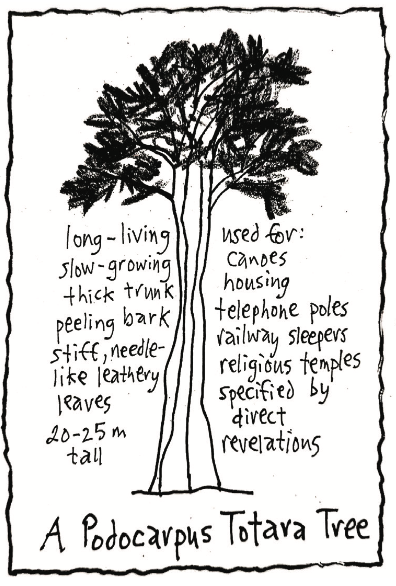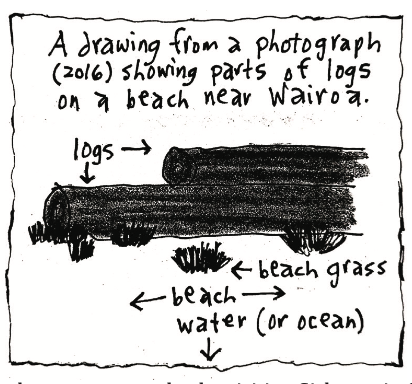Table of Contents
You can purchase Nieuw Zeeland An English-Speaking Polynesian Country With A Dutch Name: A Humorous History of New Zealand by Geoffrey Corfield from Amazon today.

Maori Religions
Also mixed up in this period of unarmed warfare over land and dogs, is religion. The Maori never stop inventing new religions.
The loss of warfare and armed conflict has been a drastic cultural change for the Maori. They had been slaughtering and eating each other and fighting somebody, since long before Abel Tasman came along, and now they didn’t have this pastime anymore. They do however find a new outlet for their energies and creativity once devoted to war, by continuing to invent new religions. Their imagination is boundless.
1833 – There is a religion in The Bay of Islands/Hokianga Harbour areas called “Papahurihia” (the Fiery God), which disliked both Catholics and Protestants, but especially Protestants whose heaven they said “had nothing but books to eat”. Sunday was on a Saturday, there was a serpent or lizard to worship, and although there was a heaven and a hell, missionaries were not allowed to enter the heaven part.
After 1872 – When Te Kooti is in sanctuary in Te Kuiti, he invents a non-violent version of his earlier violent religion, and calls it “The Ringatu Church”. It is based on a belief in the coming of a New Jerusalem and a new leader. It involves a star appearing in the east, then two stars, then a great cloud (it does not say if the cloud has any angels or voices in it). In 1883, the year of his own death, Te Kooti predicts that a new leader will appear in 26 years or less (before 1919, several claimants to being the new leader do appear).
Te Kooti made this whole religion up himself. He wrote all the songs, prayers, hymns and scriptures; chose four yearly celebration dates and the 12th of each month to be a Holy Day; and also went with Saturdays as the main church-going day of the week, not Sundays.
1885 – In Waihou Valley near Hokianga Harbour, three Maori women prophets start a new settlement in which people could shelter from the destruction of the world due to happen they said at the end of March 1885. But when the world does not end at the end of March 1885, most of the believers in the settlement (now disbelievers) leave, and the movement splinters into two factions that fly white flags and require everybody entering the settlement to wear white or have their clothes burned (especially if they were wearing red or black). The leaders of both factions are arrested on 22 July 1887.
1893 – A Maori named Hone Riiwi Toia from Waimate North, Bay of Islands; leads a breakaway Wesleyan religion known under a number of different names, in which he is a prophet communicating with spirits including a whistling serpent. He and the serpent lead a long-time local Maori protest against property tax, vehicle tax, hunting regulations, and a dog tax (serpents were exempt).
In 1898 he and 20 of his armed followers are arrested in Waima, Hokianga Harbour. Toia is imprisoned, released in 1899, and dies in 1933. Nobody knows what happened to the serpent.
After 1893 – One day sometime after 1893, a Maori named Te Matenga Tamati, who was somewhere around 60 years old and lived somewhere near Frasertown, Wairoa, Hawke’s Bay; has a direct revelation from God. He is told that he is the spiritual successor to Te Kooti (d. 1893), that he should form a new religion called “The Religion of the New Moon” (or “The Church of the New World”), and that he should follow divine instructions to build a temple of 12 log pillars, each one 12 yards long, and each one named after one of Jacob’s 12 sons. So off he goes to fulfil his calling. (Note: Some sources state the logs were 12 metres long. But would a direct revelation from God use the metric system in 1893 British colonial New Zealand?)

Before the end of the century (somewhere less than seven years later), 12 Totara trees for the 12 log pillars have been selected from the Ngamoro Range forests to the east of Lake Waikaremoana. The divine instructions are to float these logs down the rivers that flow out of the lake down to the coast at Wairoa, untouched by human hands (the spiritual mission would, however, allow the use of human hands to get the logs out of the forest and down to the lake, and through the lake to the Waikare River). But, as there were no divine instructions as to where the temple should actually be built once the logs got to the sea, Tamati’s message to his followers is that wherever the log named Joseph washed ashore, that would be the location for the temple.
It is not until March 1904 though, that the direct revelation provides enough water in the rivers (through a divine flood) to wash the logs all the way down the rivers and out into the sea. The 11 logs not named Joseph then all end up on a beach east of Wairoa near the Whakaki Lagoon.
The log named Joseph, however, drifts away all on its own farther east before coming to rest at Waikokopu near the Mahia Peninsula. This location though is not within the designated building area for the temple according to the divine instructions of the direct revelation, and although the log named Joseph is towed back to join the other 11 logs on the beach (by ship with a minimal use of human hands); Tomati’s prophesy is that the temple cannot be built. The conditions are just not right (even though at that time temples built according to divine revelations were exempt from requiring building permits under the building code, and did not need planning permission). The logs and the Religion of the New Moon (or Church of the New World) would just have to wait for another prophet to come along to finish the job.

Tomati dies in 1914. Nobody has yet shown up to carry on the divine will. The temple has not been built. The logs are still waiting. Anyway, that’s the story as it was then.
This is the story as it is now…On a beach east of Wairoa near the Whakaki Lagoon, there are 12 logs. Some of them are 40 feet long (13.3 yards/12.2 metres), and three feet thick (1 yard/.91 metres). Some of them aren’t. Some of them are more broken and weather-beaten than others. Beach grass is growing around them. They aren’t the ideal logs for building a temple with. They probably wouldn’t meet the building code.
They are on a difficult to get to section of beach and they are seldom asked about or visited. But some people know that they are there. It is not known however, which one is named “Joseph”.
__________________________
You can purchase Nieuw Zeeland An English-Speaking Polynesian Country With A Dutch Name: A Humorous History of New Zealand from Amazon today.

If you enjoyed this BFD article please consider sharing it with your friends.









